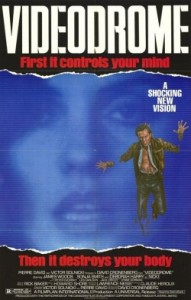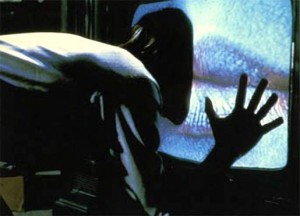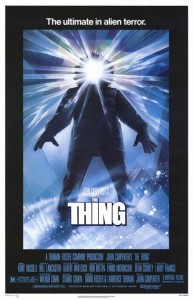(Originally Posted March 30, 2008)
I’m starting up a new series of posts about the media that left a lasting impact on me. Not sure why. Maybe so you can scar your children with this stuff too. When I was in sixth or seventh grade, I was selected by my school to be sent to a “writers conference” to meet with and interview published writers. I don’t remember much, not even which writers were there, but they all seemed incredibly old. The only writer I recall talking with told me that I had to “immerse myself in media.” He suggested several movies that I “had to see.” One of these was called Videodrome.
A few weeks later, I had my 12th birthday. My dad had gotten into the habit of renting a beta cassette (I know, right?) or laser disk player and a handful of movies for our birthday sleepovers. One of the movies I asked him to rent was this mysterious Videodrome. I don’t know why Dad didn’t check the rating or even read the description of the movie — maybe he just trusted me — but at about ten o’clock that night, Videodrome left a bulging scar across my brain.
It’s hard to summarize Videodrome. Thankfully, Wikipedia can do that for me, but for the link-impaired, a high-level plot summary goes something like this: Max Renn, a sleazy television executive (played James Woods, natch) is searching for new material for his network when he discovers a plotless torture show (called “Videodrome”) that might actually be snuff tv. Renn begins to hallucinate and eventually learns that the hallucinations are a side-effect of a brain tumor caused by the Videodrome broadcast. After being programmed by Videodrome execs, Renn murders his own partners. He is later reprogrammed by the daughter of an eccentric media professor and goes on to kill the villains who created Videodrome before seemingly committing suicide at the film’s conclusion.
All I really remembered was Debbie Harry as a crazy S&M chick who pierces James Woods’ ear during sex (where was child protective services??? I was 12!), the red clay room where the Videodrome snuff films are filmed, and a scene in which a gun fuses with Woods’ hand. Oh, and there’s a reallycreepy moment when Woods tries to make out with his tv…
Yet for as disturbing as Videodrome is, it actuallyhad a lasting positive impact on me creatively. It was perhaps my first step into the often frightening but exhilarating space between reality and fantasy. Videodrome is now a cult classic and I’m sure entire PhD papers have been written on its cultural relevance and themes. But it’s an important part of my creative development because it actually made me think:
- I experienced a story where the narrator is unreliable and reality can’t really be trusted. This is a well-used convention now, but circa 1985 I hadn’t seen anything like it.
- It left me with big questions. Because the narrator is unreliable, I had to question everything about the story. Does the protagonist really kill himself at the end of the film? In shedding his old flesh, does he destroy Videodrome as his (probably dead) girlfriend instructs?
- It introduced me to David Cronenberg, one of the most challenging directors of the past fifty years. Nearly every Cronenberg movie has left a lasting impact on me (especially The Brood, Dead Ringers, and The Fly).
- It has mature and complex themes. Though my 12-year old mind had no idea what a “theme” was, nearly every movie I had seen up to that point was focused on relatively simple themes, such as the battle of good versus evil. But Videodrome’s”betrayal of the body” theme (which recurs in many of Cronenberg’s films, and is most graphically depicted in The Fly) is deeply disturbing and forces the viewer to confront an inescapable aspect of the human condition (we get sick and die).
- The “media will control you mind” theme has also become extremely well-tread, but Videodrome was the first movie that made me even start to consider the power of tv (and its possible negative effects).
- It was the first film that made me consider that an antagonist could be something other than a flesh-and-blood villain. In many ways, the pervasive, tumor-inducing broadcast of Videodrome is a precursor to the Matrix and similar disembodied threats.
- It’s about an anti-hero. Max Rennis a far cry from Luke Skywalker, with virtually no redeeming qualities. Yet the story still draws you in, and somehow you end up rooting for him. This taught me that stories can have all types of heroes, and sometimes those with the greatest flaws are the most interesting.
- It gave me courage to watch other films. I think that most of the kids at the sleepover got up and went into another room at some point during Videodrome and didn’t finish watching it. Only my younger brother (you should see how weird he turned out…) and I sat through the whole thing. Afterwards, I realized that if I could make it through something as genuinely disturbing as Videodrome, I could probably watch nearly anything that aired on cable television, including other “bad influences.”
So, I guess that weird and incredibly irresponsible writer was right. Even though I was only 12, I really needed to see Videodrome.

 (Originally posted April 2, 2008)
(Originally posted April 2, 2008) 

